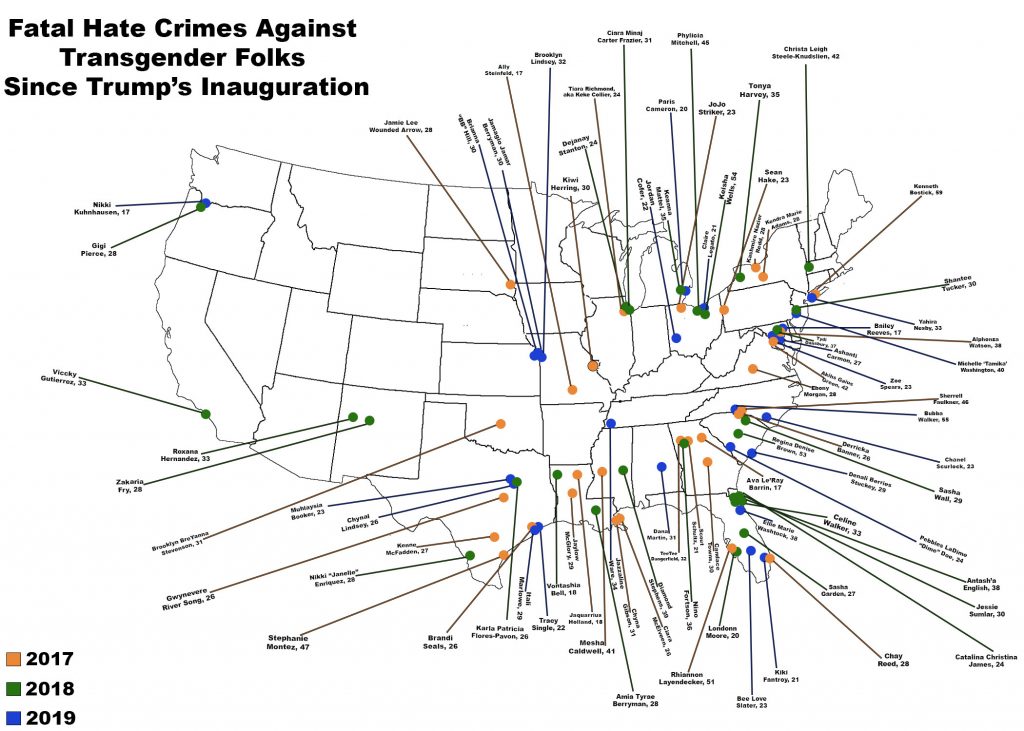By Izzy Rutkey
Since Donald Trump was inaugurated as the 45th president of the United States on January 20, 2017, there has been a spike in hate crimes against marginalized peoples, including people of color, LGBTQIA+ individuals, and immigrants. In particular, transgender folks living in the US have experienced increased transphobic violence and fatal hate crimes. This violence against marginalized peoples is a product of the hateful comments made by the president and the actions he condones, and even encourages, among his supporters.
Trump’s timeline of hate is expansive. He and his administration have repeatedly taken away protections for the transgender community:
- January 20, 2017 (inauguration day): all mentions of LGBTQIA+ issues are removed from the official White House website
- February 15, 2017: the Department of Justice announces that it will no longer challenge a national hold on protections for transgender students
- February 22, 2017: the Departments of Justice and Education revoke the Obama Administration’s guidelines about the obligations to transgender students under Title IX
- July 26, 2017: a ban on transgender individuals serving in the military is reinstated
- October 6, 2017: the Department of Justice implements a “license to discriminate” against LGBTQIA+ Americans and other marginalized communities
These are just from Trump’s first year in office; the list goes on and on. The Trump Administration has not been friendly to the transgender community and has in fact been openly hostile.

This map displays the locations of 82 fatal hate crimes against transgender folks in the years 2017, 2018, and 2019. Unfortunately, this number does not reflect all such acts of violence, but only those reported by the Human Rights Campaign in their yearly reports of violence against the transgender community. There have been and will be many more hate crimes that were not considered as such and/or were not reported to the HRC.
What can we learn from this?
A hate crime is a violent or property crime that is “motivated in whole or in part by an offender’s bias against a race, religion, disability, sexual orientation, ethnicity, gender, or gender identity” (Southern Poverty Law Center).
Evan’s questions to consider: What do we know from research on hate crimes? Are there patterns that can help us understand and prevent them? While there are definitely policy issues at the federal level (and I love the timeline) do we know anything about other possible solutions or policy levers at the local or community level that could help?
2017
“Caring and passionate;” “Loved to make people laugh;” “Constant fighter for human rights;” “One of the sweetest people you’ll ever meet;” “Would do anything for you”
Human Rights Campaign “Violence Against the Transgender Community in 2017” Report
From age 17 to age 59, from Florida to New York to South Dakota, at least 29 transgender people were fatally shot or killed by other violent means in 2017. Say their names.
Mesha Caldwell, Sean Hake, Jamie Lee Wounded Arrow, JoJo Striker, Tiara Richmond (KeKe Collier), Chyna Gibson, Ciara McElveen, Jaquarrius Holland, Akihs Gaius Green, Alphonza Watson, Chay Reed, Kenneth Bostick, Sherrell Faulkner, Kenne McFadden, Kendra Marie Adams, Ava Le’Ray Barrin, Ebony Morgan, TeeTee Dangerfield, Jaylow McGlory, Gwynevere River Song, Kiwi Herring, Kashmire Nazier Redd, Derricka Banner, Scout Schultz, Ally Steinfeld, Stephanie Montez, Candace Towns, Brooklyn BreYanna Stevenson, Brandi Seals, and Rhiannon Layendecker.
2018
“So sweet and loving;” “Funny and kind;” “Incredible personality;” “The nicest person ever;” “Just trying to live her best life;” “Great lady with a big heart”
Human Rights Campaign “Violence Against the Transgender Community in 2018” Report
From age 18 to age 54, from Oregon to Louisiana to Massachusetts, at least 27 transgender people were fatally shot or killed by other violent means in 2018. Say their names.
Christa Leigh Steele-Knudslien, Viccky Gutierrez, Celine Walker, Tonya Harvey, Zakaria Fry, Phylicia Mitchell, Amia Tyrae Berryman, Sasha Wall, Karla Patricia Flores-Pavón, Nino Fortson, Gigi Pierce, Roxana Hernández, Antash’a English, Diamond Stephens, Cathalina Christina James, Keisha Wells, Sasha Garden, Jessie Sumlar, Vontashia Bell, Dejanay Stanton, Shantee Tucker, Londonn Moore, Nikki ‘Janelle’ Enriquez, Ciara Minaj Carter Frazier, Regina Denise Brown, Tydi Dansbury, and Keanna Mattel.
2019
“Loved by many;” “Full of life;” “Unapologetically correct about [her] feelings;” “He tried to give the best to everyone;” “The best to be around;” “A good spirit”
Human Rights Campaign “Violence Against the Transgender Community in 2019” Report
From age 17 to age 55, from Washington to Texas to Michigan, at least 26 transgender or gender non-conforming people were fatally shot or killed by other violent means in 2019. Say their names.
Dana Martin, Ellie Marie Washtock, Jazzaline Ware, Ashanti Carmon, Claire Legato, Muhlaysia Booker, Michelle ‘Tamika’ Washington, Paris Cameron, Chynal Lindsey, Chanel Scurlock, Zoe Spears, Brooklyn Lindsey, Denali Berries Stuckey, Tracy Single, Bubba Walker, Kiki Fantroy, Jordan Cofer, Pebbles LaDime ‘Dime’ Doe, Bailey Reeves, Bee Love Slater, Jamagio Jamar Berryman, Itali Marlowe, Brianna ‘BB’ Hill, Nikki Kuhnhausen, and Yahira Nesby.
In creating this blog post and the associated image, I was inspired by the “United States of Attica” piece by Faith Ringgold. Her piece demonstrates the power of maps in displaying sociological issues.